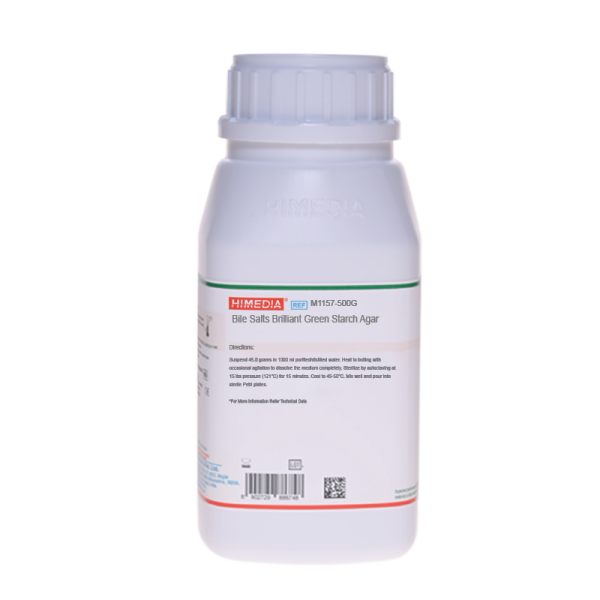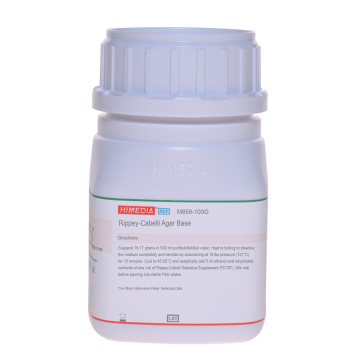 Your enquiry has been submitted
Your enquiry has been submitted
Bile Salts Brilliant Green Starch Agar
Aeromonas species#CC293D
Intended Use
Recommended for selective isolation and identification of Aeromonas hydrophila from food and environmental specimens.
Composition
| Ingredients | g/L |
|---|---|
| Proteose peptone | 10.000 |
| HM peptone B # | 5.000 |
| Bile salts | 5.000 |
| Starch, soluble | 10.000 |
| Brilliant green | 0.0005 |
| Agar | 15.000 |
Final pH (at 25°C): 7.2±0.2
**Formula adjusted, standardized to suit performance parameters
# Equivalent to Beef extract
Directions
Suspend 45.0 grams in 1000 ml purified/distilled water. Heat to boiling with occasional agitation to dissolve the medium completely. Sterilize by autoclaving at 15 lbs pressure (121°C) for 15 minutes. Cool to 45-50°C. Mix well and pour into sterile Petri plates.
Principle And Interpretation
Aeromonas hydrophila is a facultative anaerobic gram-negative organism often found in the environment, particularly in water and sewage. Aeromonas may not be truly indigenous to the marine environment but may have a transient existence after entering salt water via rivers or sewage inputs (1). Foods that come in direct contact with water like fish and seafood products are most often contaminated with Aeromonas species. In humans, Aeromonas hydrophila is associated with extra-intestinal infections such as wound infections, septicemia (2) and meningitis (3). Wound infections are associated with exposure to water or soil (4). Bile Salts Brilliant Green Starch Agar, formulated by Nishikawa and Kishi (5) is recommended for the selective isolation and identification of Aeromonas hydrophila from food and environmental specimens. This medium is recommended by APHA (6) employs starch hydrolysis as the differential system and bile salts and brilliant green as inhibitory substances. Proteose peptone and HM peptone B supply essential growth nutrients.
Type of specimen
Food samples; Environmental samples
Specimen Collection and Handling
Test food samples should be processed as soon as possible since Aeromonas are capable of growing at 5°C. Aseptically weigh 25 gram of the food sample and add 225 ml of sterile Alkaline Peptone Water (M618). Blend it for 2-3 minutes. Dilute further if required and surface plate 0.1 ml on SA Agar Base (M1177) and Bile Salts Brilliant Green Starch Agar (M1157). Incubate at 25-30°C for 18-24 hours. After incubation, flood the plates with 5 ml of Lugols Iodine solution (S019). Aeromonas hydrophila will exhibit a clear zone of hydrolyzed starch against a dark background. After use, contaminated materials must be sterilized by autoclaving before discarding.
Warning and Precautions
Read the label before opening the container. Wear protective gloves/protective clothing/eye protection/ face protection. Follow good microbiological lab practices while handling specimens and culture. Standard precautions as per established guidelines should be followed while handling specimens. Safety guidelines may be referred in individual safety data sheets.
Limitations :
- As organisms differ in their nutritional requirements, some fastidious organisms may be inhibited or may show poor growth.
- Biochemical and serological tests must be performed for confirmation of isolated organisms.
Performance and Evaluation
Performance of the medium is expected when used as per the direction on the label within the expiry period when stored at recommended temperature.
Quality Control
Appearance: Light yellow to greenish yellow homogeneous free flowing powder
Gelling: Firm, comparable with 1.5% Agar gel
Colour and Clarity of prepared medium: Green coloured, slightly opalescent gel forms in Petri plates.
Reaction: Reaction of 4.5% w/v aqueous solution at 25°C. pH: 7.2±0.2
pH: 7.00-7.40
Cultural Response
Cultural characteristics observed after an incubation at 25-30°C for 18-24 hours.
| Organism | Inoculum (CFU) | Growth | Recovery |
|---|---|---|---|
| Aeromonas hydrophila ATCC 7966 (00063*) | 50-100 | good-luxuriant | >=50% |
| Escherichia coli ATCC 25922 (00013*) | >=104 | inhibited | 0% |
| Staphylococcus aureus subsp. aureus ATCC 25923 (00034*) | >=104 | inhibited | 0% |
Key: (*) Corresponding WDCM numbers.
Storage and Shelf Life
Store between 10-30°C in a tightly closed container and the prepared medium at 20-30°C. Use before expiry date on the label. On opening, product should be properly stored dry, after tightly capping the bottle in order to prevent lump formation due to the hygroscopic nature of the product. Improper storage of the product may lead to lump formation. Store in dry ventilated area protected from extremes of temperature and sources of ignition. Seal the container tightly after use. Product performance is best if used within stated expiry period.
Disposal
User must ensure safe disposal by autoclaving and/or incineration of used or unusable preparations of this product. Follow established laboratory procedures in disposing of infectious materials and material that comes into contact with sample must be decontaminated and disposed of in accordance with current laboratory techniques (4,7).
Reference
- Rippey S. R. and Cabelli V. J., 1979, Appl. Environ. Microbiol, 38:108
- Davis W. A. III, Kane J. G., and Garagusi V. F. 1978, Human Aeromonas Infections: A Review of the Literature and a Case Report of Endocarditis, Medicine, 57:267.
- Ellison R. T. and Mostow, S. R., 1984, Arch. Intern. Med. 144:2078.
- Isenberg, H.D. Clinical Microbiology Procedures Handbook 2nd Edition.
- Nishikawa. Y. and Kishi T., 1987, Epidem. Inf., 98:331.
- Salfinger Y., and Tortorello M.L., 2015, Compendium of Methods for the Microbiological Examination of Foods, 5th Ed., American Public Health Association, Washington, D.C.
- Jorgensen, J.H., Pfaller, M.A., Carroll, K.C., Funke, G., Landry, M.L., Richter, S.S and Warnock., D.W. (2015) Manual of Clinical Microbiology, 11th Edition. Vol. 1.
Revision: 03/2024
| Product Name | Bile Salts Brilliant Green Starch Agar |
|---|---|
| SKU | M1157 |
| Product Type | Regular |
| Physical Form | Powder |
| Origin | Animal |
| Packaging type | HDPE |
| References | 1. Rippey S. R. and Cabelli V. J., 1979, Appl. Environ. Microbiol, 38:108 |
| Customized Product Available | No |








